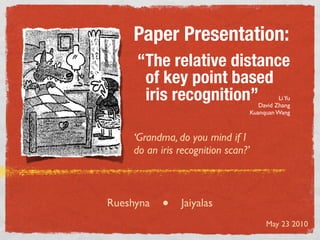
The Relative Distance of Key Point Based Iris Recognition
- 1. Paper Presentation: “The relative distance of key point based iris recognition” Li Yu David Zhang Kuanquan Wang ‘Grandma, do you mind if I do an iris recognition scan?’ Rueshyna ● Jaiyalas May 23 2010
- 2. OUTLINE The Relative Distance of Key Point Based Iris Recognition Iris Image Preprocessing Features Extracting Experimental Results Verification Identification Conclusion
- 3. OUTLINE The Relative Distance of Key Point Based Iris Recognition Iris Image Preprocessing Features Extracting Experimental Results Verification Identification Conclusion
- 5. IMAGE PREPROCESSING (2/6) Longest Chord (x,y) (xp,yp)
- 6. IMAGE PREPROCESSING (3/6) Inner Boundary Outer Boundary
- 8. IMAGE PREPROCESSING (5/6) r 1 0 0 π Φ
- 9. IMAGE PREPROCESSING (6/6) Φ 0 π r 64 pixels 1 256 pixels
- 10. OUTLINE The Relative Distance of Key Point Based Iris Recognition Iris Image Preprocessing Features Extracting Experimental Results Verification Identification Conclusion
- 11. GABOR FILTER (1/7) Original Image Gabor Filter Result Image
- 13. GABOR FILTER (3/7) For Multi-channels: θ = 0, 45, 90, 135 T = α = β = 4, 8, 16, 32
- 14. GABOR FILTER (5/7) even-symmetric (real part) φ = 0, 90 odd-symmetric (imaginary part) θ = 0, 45, 90, 135 Unsupervised Texture Segmentation Using Gabor Filters Anil K. Jain Farshid Farrokhnia T = α = β = 4, 8, 16, 32 Multichannel Texture Analysis Using Localized Spatial Filters Alan Conrad Bovik Marianna Clark Wilson S. Geisler
- 15. GABOR FILTER (4/7) φ = 0, 90 θ = 0, 45, 90, 135 Unsupervised Texture Segmentation Using Gabor Filters Anil K. Jain Farshid Farrokhnia T = α = β = 4, 8, 16, 32 Multichannel Texture Analysis Using Localized Spatial Filters Alan Conrad Bovik Marianna Clark Wilson S. Geisler
- 16. GABOR FILTER (6/7) φ = 0, 90 2 Parts θ = 0, 45, 90, 135 16 Channels T = α = β = 4, 8, 16, 32
- 17. GABOR FILTER (7/7) φ = 0, 90 2 Parts θ = 0, 45, 90, 135 32 Filters 16 Channels T = α = β = 4, 8, 16, 32
- 18. FILTER EXAMPLE (1/3) T = 4 ;θ = 0 T = 8 ; θ = 45 4 Channels T = 16 ; θ = 90 T = 32 ; θ = 135
- 19. FILTER EXAMPLE (2/3) T = 4 ;θ = 0 T = 8 ; θ = 45 4 Even-Symmetric Filters T = 16 ; θ = 90 with φ = 0 T = 32 ; θ = 135
- 21. KEY POINTS (1/4) 256 pixels 64 pixels 32 pixels 32 pixels To divide filtered image into 16 blocks
- 22. KEY POINTS (2/4) 256 pixels 64 pixels → obtain a key point: by here, m = 64
- 23. KEY POINTS (3/4) for each filtered image 16 key points
- 24. KEY POINTS (4/4) 32 filtered images exist 32 filters 16×32 = 512 key points
- 25. 32 blo RELATIVE DISTANCE (1/3) ck s 32 filtered images To obtain the center of key points in the jth blocks by:
- 26. RELATIVE DISTANCE (2/3) for some block j: Oj KPn Dj(n)
- 27. RELATIVE DISTANCE (3/3) 32 filtered images There are 32 D in 1st blocks There are 32 D in 2nd blocks 16 x 32 . . = 512 Distances . = 512 Features!! There are 32 D in 16th blocks
- 28. OUTLINE The Relative Distance of Key Point Based Iris Recognition Iris Image Preprocessing Features Extracting Experimental Results Verification Identification Conclusion
- 29. EXPERIMENTS Database Experiments Modes CASIA Verification 108×7 = 756 Identification 320×280 pixels private database 254×4 = 1016 768×568 pixels
- 30. OUTLINE The Relative Distance of Key Point Based Iris Recognition Iris Image Preprocessing Features Extracting Experimental Results Verification Identification Conclusion
- 31. NUMBER OF COMPARISONS (1/2) CASIA private database 570,780 total 1,031,240 total 2,268 intra-class 1524 intra-class 568,512 inter-class 1,029,716 inter-class
- 32. NUMBER OF COMPARISONS (2/2) Small overlaps CASIA private database
- 33. ACCURACY ROC curve 0.008% 0.0015% CASIA private database
- 34. PARAMETER M control tradeoff accuracy speed small m lose feature noise sensitive large m many redundant features
- 35. OUTLINE The Relative Distance of Key Point Based Iris Recognition Iris Image Preprocessing Features Extracting Experimental Results Verification Identification Conclusion
- 36. IDENTIFICATION CASIA : 108×(3+4) private : 254×(3+1) Testing Training
- 37. OUTLINE The Relative Distance of Key Point Based Iris Recognition Iris Image Preprocessing Features Extracting Experimental Results Verification Identification Conclusion
- 38. MISMATCHING Lower resolution!! Eyelids obscuring!! Darkness!!
- 39. FEATURES (1/5) Good recognition rate (with a better choice of m) point number in a block
- 40. FEATURES (2/5) Can avoid influence of rotation transform
- 41. FEATURES (3/5) Feature dimensions is only 512
- 42. FEATURES (4/5) Compared with Daugman’s and Ma’s methods integrating location and modality info. more powerful when: FAR > 0.008% (in CASIA) FAR > 0.0015% (in private database)
- 43. FEATURES (5/5) 0.008% 0.0015% CASIA private database
- 44. FINALLY This proposed method is more suitable for medium security such as those for civil access control (require a high match rate) Daugmen and Ma’s methods are more suitable for high security system such as military departments (require a low FAR)
